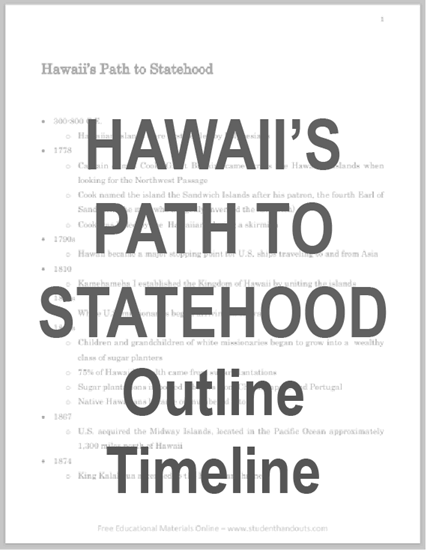| Hawaii's Path to Statehood Timeline Outline PDF |
|---|
| www.studenthandouts.com ↣ Geography ↣ Northern America ↣ U.S.A. ↣ U.S. West ↣ Hawaii |
| Free Printable History Outline-Timeline Worksheet for Grades 7-12—Scroll Down to Print (PDF) |
 |
    |
|
300-800 C.E. ‣ Hawaiian Islands were first settled by Polynesians 1778 ‣ Captain James Cook (Great Britain) came across the Hawaiian Islands when looking for the Northwest Passage ‣ Cook named the island the Sandwich Islands after his patron, the fourth Earl of Sandwich (the man who allegedly invented the sandwich) ‣ Cook was killed by the Hawaiians during a skirmish 1790s ‣ Hawaii became a major stopping point for U.S. ships traveling to and from Asia 1810 ‣ Kamehameha I established the Kingdom of Hawaii by uniting the islands 1820s ‣ White U.S. missionaries began arriving in Hawaii 1840s ‣ Children and grandchildren of white missionaries began to grow into a wealthy class of sugar planters ‣ 75% of Hawaii's wealth came from sugar plantations ‣ Sugar plantations imported laborers from China, Japan, and Portugal ‣ Native Hawaiians became outnumbered 3 to 1 1867 ‣ U.S. acquired the Midway Islands, located in the Pacific Ocean approximately 1,300 miles north of Hawaii 1874 ‣ King Kalakaua ascended to the Hawaiian throne 1875 ‣ King Kalakaua signed the Reciprocity Treaty with the U.S. ‣ Hawaii could sell duty- and tax-free sugar to the United States ‣ U.S. could build Pearl Harbor naval base on the Hawaiian island of Oahu 1877 ‣ White group known as the Honolulu Rifles forced King Kalakaua to sign the Constitution of the Kingdom of Hawaii ‣ Hawaii became a constitutional monarchy ‣ Suffrage only for non-Asian males, at least 20 years old, who owned property 1890 ‣ McKinley Tariff repealed the sale of duty- and tax-free sugar to the U.S. ‣ White plantation owners wanted the U.S. to annex Hawaii to avoid these taxes 1891 ‣ King Kalakaua died ‣ Queen Liliuokalani, his sister, ascended to the throne ‣ Liliuokalani nullified the Constitution of the Kingdom of Hawaii 1893 ‣ January 14—U.S. Ambassador John Leavitt Stevens led the pro-annexation Committee of Public Safety to intimidate Queen Liliuokalani ‣ January 16—162 U.S. Marines and sailors made a visible presence ‣ January 17—Liluokalani forced to relinquish her throne ‣ February 1—Hawaii proclaimed a protectorate of the United States January 4, 1894 ‣ Sanford Ballard Dole proclaimed the Republic of Hawaii January 16, 1895 ‣ Queen Liliuokalani arrested in connection with the 1895 Counter-Revolution in Hawaii ‣ She served one year of House Arrest in Iolani Palace ‣ She abdicated in order to save the lives of her supporters who were on death row 1898 ‣ President McKinley officially annexed Hawaii ‣ Hawaii became a dependent republic run by its white aristocracy 1900 ‣ Hawaii Organic Act ‣ Hawaii officially reclassified as a territory ‣ Suffrage for all adult males ‣ Nonvoting delegate in the U.S. House of Representatives 1903 ‣ Congress denied the Hawaiian legislature the right to draw up a state constitution ‣ This would have been the first step toward Hawaiian statehood 1905-1910 ‣ Queen Liliuokalani filed a series of unsuccessful claims and lawsuits against the United States for the loss of crown lands 1919 ‣ Prince Kalanianaole (son of the late King Kalakaua) introduced the first statehood bill ‣ All statehood bills failed due to fears over Japanese imperialism in the Pacific 1934 ‣ Jones-Costigan Act ‣ Severely limited U.S. imports of foreign sugar, including sugar from Hawaii ‣ White plantation owners began working for statehood 1937 ‣ U.S. Congress held statehood hearings on Hawaii 1940 ‣ Hawaiians voted 2 to 1 for statehood 1941 ‣ December 7—Pearl Harbor attacked by the Japanese (World War II) ‣ Hawaii under martial law until 1944 1947 ‣ House of Representatives voted 196 to 133 for Hawaiian statehood 1948 ‣ Hawaiian statehood movement stalled ‣ Senator Hugh A. Butler (Republican, Nebraska), chairman of the House Rules Committee, feared that communists had infiltrated the Hawaiian Democratic Party 1949 ‣ Hawaii's territorial legislature wrote a democratic state constitution in hopes of acquiring statehood 1953 ‣ Delegate Joseph Farrington proposed yet another Hawaiian statehood bill ‣ Passed in the House of Representatives 1954 ‣ Hawaiian statehood bill approved by the Senate ‣ But Senate attached it to Alaska's pending statehood bill ‣ Bill went back to the House for approval ‣ Bill died in the House because Speaker Joseph William Martin, Jr. (Republican, Massachusetts) wanted statehood for Hawaii but not for Alaska 1959 ‣ January 3—Alaska became the 49th state ‣ Senate passed the Hawaii Statehood Bill ‣ August 21—Hawaii became the 50th state Cllick here to print (PDF file). |
| www.studenthandouts.com ↣ Geography ↣ Northern America ↣ U.S.A. ↣ U.S. West ↣ Hawaii |








